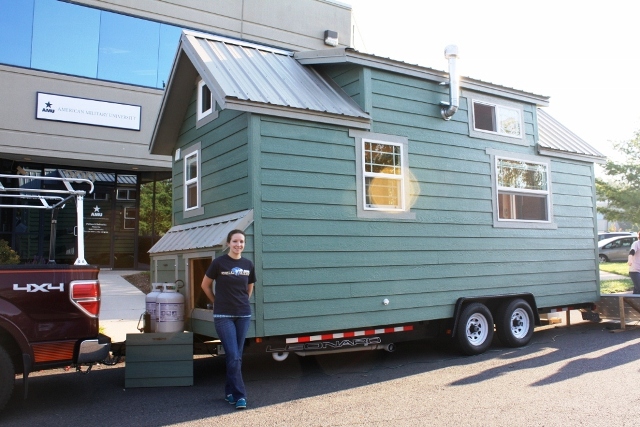
Travelling from southwest Virginia up I-81 recently, Sarah McNair gave a literal nod to the Tiny House movement. She was hauling her nearly completed 150 square foot custom creation north to visit friends and colleagues at her university in Charles Town WV.
Only reaching top speeds of 50-55 mph (partially because of the load and for safety) McNair and her chauffeur, aka “Dad,” towed a Tiny House that she has built almost entirely on her own.
On one of their many stops to refuel, so many people come up to check out the house and ask questions that the gas station manager finally asked if they would mind moving on so he could keep the pumps flowing.
McNair ‘s unique undertaking started out as a bit of a whim but has since consumed the better part of her time and thoughts as she planned and executed a project of this magnitude. She had been working toward her online Masters degree in Environmental Policy and Management at American Military University. As the decidedly dreaded thesis paper requirement came on the radar, it occurred to her that perhaps she could build something instead of just write about it. After all, who wouldn’t want to get out of writing a 60-80 page paper?
Her advisor and “virtual hands-on” professor Dr. Elizabeth D’Andrea agreed that she could build a Tiny House for her now 3-D thesis. Last spring McNair began constructing the house at her parents’ home in Newport.
“I have always liked small things like Mini Coopers; a miniature version of anything gets me ridiculously excited. I had heard about the Tiny House movement some time ago and when I considered my thesis, the idea came back to me.”

Interestingly, the movement has garnered renewed attention in the news recently, being featured on CNN, World News with Diane Sawyer and internet newsfeeds as well as John Carlin’s Virginia locally.
McNair is immersed in the sustainability movement, which she says Tiny House exemplifies. She enjoys giving tours (which don’t take very long!) of the 150 square foot house. McNair causes most to take an impromptu mental inventory of the surplus “stuff” in their own lives. Since space is at such a premium, nearly every area serves dual functions. McNair believes the biggest motivation for living in a Tiny House is financial; at an average cost of $20-50 thousand, it is possible to live mortgage-free fairly quickly.
There are some sticky zoning issues as people are trying to figure out just what really comprises a Tiny House. Depending on the state, it can be considered a recreational vehicle, a camper, a mobile home, a shed or an accessory building. As such, there can be varied restrictions on whether it can be occupied year-round. Once all this gets sorted out, McNair believes the movement “could blow up” and become much bigger nationwide as the allure of low expense and a “tiny footprint” (both carbon and otherwise) increasingly make sense for a segment of the population.
According to McNair many of her friends and colleagues have been “naysayers -but are impressed when they see it, saying the Tiny House is really cute and a great idea.”
She has taken great pains and occasionally extra expense to outfit the house with eco-conscious items such as low-flow faucets. But McNair may have set a new standard for renewable resources. She is constructing hand-made hardwood floors out of discarded wooden pallets—she recently came across a prize-find of five white oak pallets. Breaking down pallets, sanding and finishing the wood may be one of the most labor-intensive aspects of the project; “these floors are kicking my butt!” she says.
Climbing into the loft, which serves as a sleeping area, McNair points out that it could serve as a second den, provided guests aren’t too tall.
She also jokingly says that her Tiny House brings “eco-friendly street-cred” to both herself and her school. The fact that her advisors were willing to be flexible may be due in part to the university’s own commitment to sustainability. As American Public University System has expanded its campus, it too has adhered to environmental interests, working toward reducing low carbon footprint including building a trend-setting solar array parking lot facility.
After it was all said and done, McNair and her professor decided that she should still submit a paper on the project. The final length? About 69 pages. Looks like this thesis turned out to be anything but a tiny endeavor.
By Cheryl Vosburg

